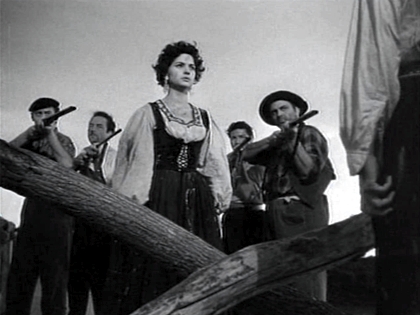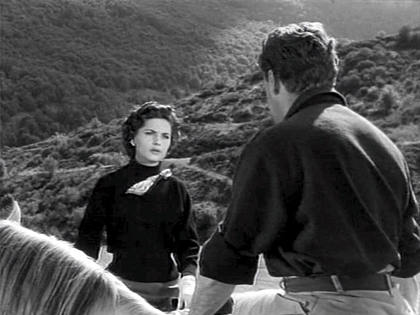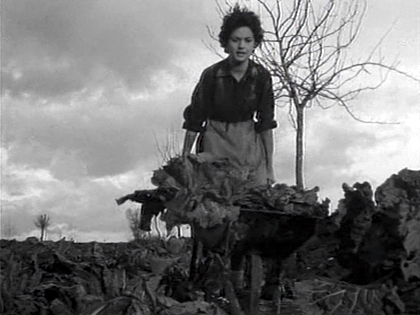Primary navigation


Spain’s Manuel Mur Oti had huge success under Franco. Since the fall of the regime he’s been written out of history. By Mar Diestro-Dópido
‘Lost and Found’ is generally a column about great but overlooked films, but in the peculiar case of Spanish director Manuel Mur Oti we’re actually talking about the obliteration of a whole magnificent career. None of his films – including his 1955 masterpiece Orgullo (Pride, pictured above) – is available on DVD, nor are his poetry or novels in print. Only two books have ever been written on Mur Oti’s film work: the first (now out of print but kindly sent to me by the Spanish Cinematheque) written in 1992 by the great Spanish critic Miguel Marías; the second accompanying a retrospective organised by the Ourense Independent Film Festival in 1999, and very hard to come by. Gone missing from Spanish cultural history, Mur Oti is now only a well-kept secret to a small number of cinephiles; although he received an honorary Goya award in 1992, he’s barely known at all to the wider Spanish public.
Mur Oti was born in Vigo in 1908, the son of a prison warden who struck lucky in the spirits business and moved the family to Cuba when Manuel was 13. There the young Mur Oti developed strong relationships with his mother and two sisters, and learned to work the land as a cowboy. The former would come to influence his powerful, fully rounded women characters throughout his filmography; the latter fed into his depiction of the extremity of the Castilian climate in Orgullo – essentially a Spanish western.
Mur Oti started making films in 1949, almost by chance, after being hugely successful at a series of other careers, including novelist, poet, scriptwriter, playwright, lawyer and even perfumer. By the time he returned to Spain in 1930, he was a well-known and highly respected figure. But what he should be remembered for are the 17 features he wrote, directed and produced (he ran his own production company) until 1976 – one of the most ambitious, striking and thematically consistent bodies of work in the history of Spanish cinema.
In Orgullo, shot and released in 1955, Mur Oti manages to gather together and distil all the recurring elements and preoccupations of his cinema: the nature of woman, human passions, and above all the power the land exerts in determining human affairs. As in his own previous film Condenados (The Condemned, 1953) – and such Hollywood epics as Gone with the Wind (1939) and Giant (1956) – Orgullo evokes the attachment of an individual to their land. The Hollywood references are not idle: for Marías, Orgullo stands comparison with the work of John Ford and William Wellman. It’s the film in which Mur Oti single-handedly invented the European western, preceding the success of Sergio Leone by a full ten years.

A spin on the Romeo and Juliet story, Orgullo tells of two families, the Mendozas and the Alzagas, who have been fighting for generations over the water from the mighty river that intersects their respective lands. The Mendoza daughter Laura (played by the beautiful, imperious Marisa Prado) returns to the farm after studying abroad, and falls in love with the Alzagas’ son Enrique. Ignoring their families’ ancestral rivalry, they decide to marry, but resentment runs rife among the workers on both farms; when drought strikes, it unleashes old grudges and drags everyone back into the conflict. Possessed by the same pride as their parents, the lovers separate and Laura – transformed into a woman as tough as the land she now has to defend – sets off with her men to find another source of water.
Shot on location in the arid lands of Castilla – in rural areas known at the time as the España negra or ‘black Spain’ by virtue of their superstition, conservatism and violent crime – Orgullo captures vividly the desperation and bleakness of the post-Civil War era. Epic black-and-white cinematography by Juan Mariné (nicknamed creador de la luz – creator of light) brings out both the outstanding beauty and the harshness of the land – devoured by blazing suns in summer and bitterly freezing in winter – as immortalised previously by the paintings of Goya, the poetry of Antonio Machado and later by the films of Víctor Erice.
Outstanding in its scale and ambition, Orgullo displays a masterful control of cinematic language and genre conventions, but without ever resorting to cliché. Mur Oti slips easily and adroitly from horror (when Laura discovers her mother is dead) to epic (in depicting the search for water) to melodrama. Orgullo is above all a woman’s western – Laura’s feelings of love and pride are what propel the story forward.
Lauded as El Genio (the genius), Mur Oti was popular with critics and public alike, and Orgullo was invited to the Venice Film Festival in 1955. But it’s precisely this success that’s led to the obscuring of his achievements in the years since Franco’s death in 1975. As film scholar Alberto Mira has explained, after Franco whole genres were ignored in Spain because they had been produced within the state-sponsored commercial cinema preferred by the dictator (who was famously referred to as a cinephile by Orson Welles).

A closer look at many of these commercial genre films, however, can occasionally reveal a veiled critique of the status quo. (Mur Oti, after all, fought with the Republicans and was sent to concentration camps in both France and Spain, only to be saved by his father, who worked in the local prison.) Of course, the highly stylised Orgullo resonates with echoes of the Spanish Civil War, chiming with Franco’s vision of the war as crusade. But it is also firmly grounded in the historical reality of a tragedy that often tore whole families apart; most importantly, it exposes the absurdity of ancient disputes, the backwardness of provincialism and the devastating consequences of isolation.
The role of women is pivotal in Mur Oti’s filmography, and although Laura is inescapably linked with the land (and hence with fertility), she’s also a determined leader, very far from complying with Franco’s ideal of submissive, domestic womanhood. Most tellingly, she works the land with her own hands (something her male counterpart is never shown doing) – an action that also eliminates class boundaries. In fact the images of the land and workers, and the emphasis on collective effort, are more reminiscent of Russian filmmaking and communist propaganda than of the staunch feudalism of the Franco regime.
But Mur Oti’s work was doomed to fall into oblivion all the same. The transition to democracy in Spain fostered an implacable desire to break with everything that smacked of the old regime and its moral values. After 1976 he never directed again; his films simply did not fit with the post-Franco zeitgeist. The new mood stigmatised anything made under the Franco banner, particularly in the cultural realm. Even Carlos Saura and Luis García Berlanga were sniffed at by the younger generation for dealing with elements of Spanish life that Franco had fetishised, such as flamenco and folklore. But in the case of Manuel Mur Oti – arguably as great as either of those directors – the baby was most definitely thrown out with the bathwater.
Spanish spring: Paul Julian Smith on Spanish cinema after Franco (July 2011)
Hidden visionaries: Mar Diestro-Dópido on a touring exposition of 50 years of Spanish experimental cinema (April 2011)
Iván: Pedro Almodóvar’s eulogy to his late friend Iván Zulueta (English translation, April 2011)
Luis García Berlanga, 1921-2010: obituary by Mar Diestro-Dópido (March 2011)
Critics’ inspirations: Mar Diestro-Dópido on La Movida, Spain’s post-Franco cultural explosion (April 2011)
Goya in Bordeux reviewed by Paul Julian Smith (November 2000)
Flamenco reviewed by José Arroyo (August 2000)
Tango reviewed by Geoffrey Macnab (August 1999)